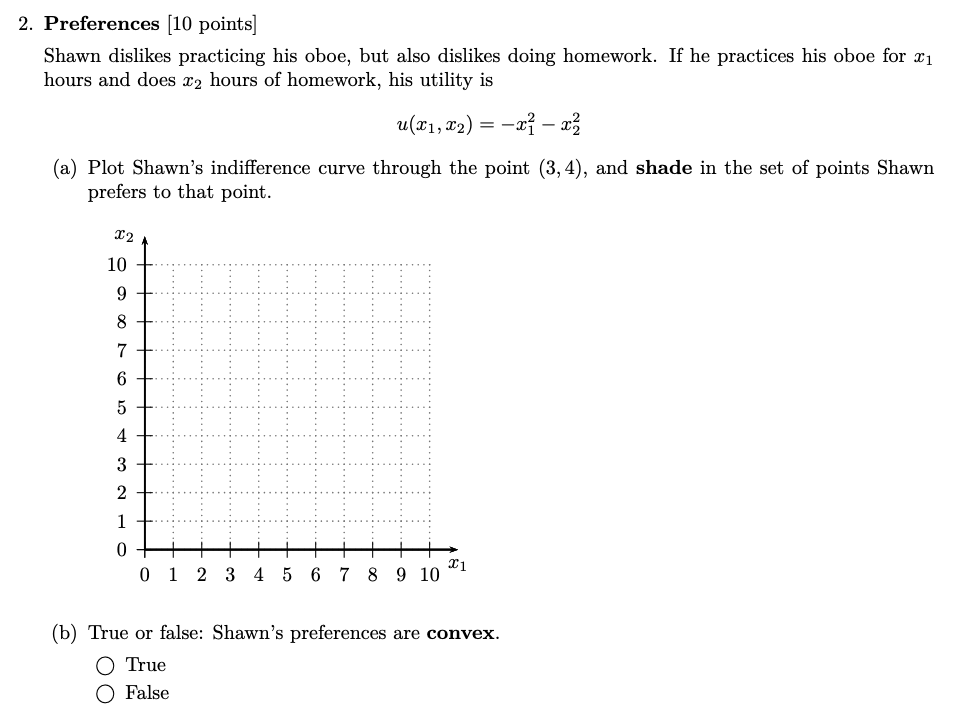Modeling Different Types of Preferences with Utility Functions
Christopher Makler
Stanford University Department of Economics
Econ 50: Lecture 4
pollev.com/chrismakler

Consider the function
What is the partial derivative of this function with respect to \(x\) evaluated at the point \((4,2)\)?

I've set up a Khan Academy course where you can practice and learn more about multivariable calculus.
(Link in syllabus)
Agenda for Today
Part I: Properties of Preferences
Part II: Examples of Utility Functions
- Monotonicity
- Convexity
- "Well-Behaved" Preferences and the "Law of Diminishing MRS"
- Perfect Substitutes
- Cobb-Douglas
- CES
- Quasilinear
Part I: Properties of Preferences
Desirable Properties of Preferences
We've asserted that all (rational) preferences are complete and transitive.
There are some additional properties which are true of some preferences:
- Monotonicity
- Convexity
- Continuity
- Smoothness
Monotonic Preferences: “More is Better"
Nonmonotonic Preferences and Satiation
Some goods provide positive marginal utility only up to a point, beyond which consuming more of them actually decreases your utility.
Strict vs. Weak Monotonicity
Strict monotonicity: any increase in any good strictly increases utility (\(MU > 0\) for all goods)
Weak monotonicity: no increase in any good will strictly decrease utility (\(MU \ge 0\) for all goods)
Example: Pfizer's COVID-19 vaccine has a dose of 0.3mL, Moderna's has a dose of 0.5mL
Convex Preferences: “Variety is Better"
Take any two bundles, \(A\) and \(B\), between which you are indifferent.
Would you rather have a convex combination of those two bundles,
than have either of those bundles themselves?
If you would always answer yes, your preferences are convex.
Concave Preferences: “Variety is Worse"
Take any two bundles, \(A\) and \(B\), between which you are indifferent.
Would you rather have a convex combination of those two bundles,
than have either of those bundles themselves?
If you would always answer no, your preferences are concave.
Common Mistakes about Convexity
1. Convexity does not imply you always want equal numbers of things.
2. It's preferences which are convex, not the utility function.
Other Desirable Properties
Continuous: utility functions don't have "jumps"
Smooth: marginal utilities don't have "jumps"
Counter-example: vaccine dose example
Counter-example: Leontief/Perfect Complements utility function
Well-Behaved Preferences
If preferences are strictly monotonic, strictly convex, continuous, and smooth, then:
Indifference curves are smooth, downward-sloping, and bowed in toward the origin
The MRS is diminishing as you move down and to the right along an indifference curve
Good 1 \((x_1)\)
Good 2 \((x_2)\)
"Law of Diminishing MRS"
Testing for Well-Behaved Preferences
Monotonicity
Convexity
- Monotonicity means getting more of each good makes you better off
- Marginal utility is the change in utility as you get more of a good
- Therefore, as long as all marginal utilities are positive, preferences are monotonic.
- Visually: if you connect any two points on an indifference curve, does it always go through the set of preferred points?
-
Sufficient (but not necessary) conditions for convexity:
- Preferences are monotonic, AND
- The MRS is decreasing in \(x_1\), AND
- The MRS is increasing in \(x_2\)
- At least one of the last two is strict


Part II: Examples of Utility Functions
How can different functional forms can be used to model different ways people think about the relationships between goods?


Preferences over Soda
Suppose one liter of soda gives you 20 "utils" of utility; so each one-liter bottle (good 1) gives you 20 utils,
and each two-liter bottle (good 2) gives you 40 utils.
Which other bundles give you the same utility as
12 one-liter bottles and 6 two-liter bottles (A)?
Which other bundles give you the same utility as
12 one-liter bottles and 2 two-liter bottle (B)?
12
24
Any combination that has 24 total liters
Any combination that has 16 total liters
16
20
4
8
12
24
16
20
4
8
A
B
pollev.com/chrismakler

Preferences over Soda
Suppose one liter of soda gives you 20 "utils" of utility; so each one-liter bottle (good 1) gives you 20 utils,
and each two-liter bottle (good 2) gives you 40 utils.
Which other bundles give you the same utility as
12 one-liter bottles and 6 two-liter bottles (A)?
Which other bundles give you the same utility as
12 one-liter bottles and 2 two-liter bottle (B)?
Any combination that has 24 total liters
Any combination that has 16 total liters
What utility function represents these preferences?
Perfect Substitutes
Goods that can always be exchanged at a constant rate.
-
Red pencils and blue pencils, if you con't care about color
-
One-dollar bills and five-dollar bills
-
One-liter bottles of soda and two-liter bottles of soda
Cobb-Douglas
An easy mathematical form with interesting properties.
-
Used for two independent goods (neither complements nor substitutes) -- e.g., t-shirts vs hamburgers
-
Also called "constant shares" for reasons we'll see later.
Normalizing Cobb-Douglas Functions
One reason to transform a utility function is to normalize it.
This allows us to describe preferences using fewer parameters.
[ multiply by \({1 \over a + b}\) ]
[ let \(\alpha = {a \over a + b}\) ]
Normalizing Cobb-Douglas Functions
One reason to transform a utility function is to normalize it.
This allows us to describe preferences using fewer parameters.
[ raise to the power of \({1 \over a + b}\) ]
[ let \(\alpha = {a \over a + b}\) ]
pollev.com/chrismakler

The utility function
represents the same preferences as the utility function
for what value of \(\alpha\)?
Constant Elasticity of Substitution (CES) Utility
COMPLEMENTS: \(r < 0\)
SUBSTITUTES: \(r > 0\)
Composite Goods
You have $1,000 in your bank account.
You have a date tonight, and stop off to buy some tic tacs.
Tic tacs cost $1 per box.
- If we think about this as a "good 1 - good 2" problem, what is good 2?
- What does the MRS measure in this case?
- Which is changing faster: \(MU_1\) or \(MU_2\)?
Quasilinear
Generally used when Good 2 is
"dollars spent on other things."
-
Marginal utility of good 2 is constant
-
If good 2 is "dollars spent on other things," utility from good 1 is often given as if it were in dollars.
Summary of Part I
When considering two goods, there are lots of ways you might feel about them — especially how substitutable the goods are for one another, which is captured by the MRS.
Different functional forms have different MRS's; so they're good for modeling different kinds of preferences.
Take the time to understand this material well.
It's foundational for many, many economic models.
Econ 50 | Fall 25 | Lecture 04
By Chris Makler
Econ 50 | Fall 25 | Lecture 04
Modeling Different Types of Preferences with Utility Functions
- 421



